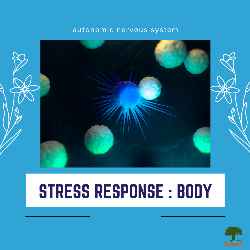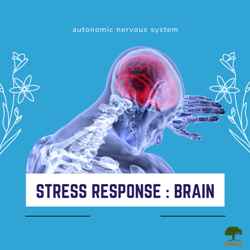Autonomic Nervous System:
 The autonomic nervous system (ANS) regulates certain body processes, such as blood pressure and the rate of breathing. This system works automatically (autonomously), without a person’s conscious effort.
The autonomic nervous system (ANS) regulates certain body processes, such as blood pressure and the rate of breathing. This system works automatically (autonomously), without a person’s conscious effort.
The ANS is the part of the nervous system that works with the internal organs, including the blood vessels, stomach, intestine, liver, kidneys, bladder, genitals, lungs, pupils, heart, and sweat, salivary, and digestive glands.
The ANS has two main divisions:
1) Sympathetic (fight or flight) and
2) Parasympathetic (rest and digest)
After the autonomic nervous system receives information about the body and external environment, it responds by stimulating body processes (sympatheticstate), or inhibiting them (parasympathetic state).
Many organs are controlled primarily by either the sympathetic or the parasympathetic division. Sometimes the two divisions have opposite effects on the same organ. For example, the sympathetic division increases blood pressure, and the parasympathetic division decreases it. Overall, the two divisions work together to ensure that the body responds appropriately to different situations.
effects on the same organ. For example, the sympathetic division increases blood pressure, and the parasympathetic division decreases it. Overall, the two divisions work together to ensure that the body responds appropriately to different situations.
Being in a sympathetic state prepares the body for stressful or emergency situations—fight or flight.
Thus, the sympathetic state increases heart rate and the force of heart contractions and widens (dilates) the airways to make breathing easier. It causes the body to release stored energy. Muscular strength is increased. Sympathetic state also causes palms to sweat, pupils to dilate, and hair to stand on end. It slows body processes that are less important in emergencies, such as digestion and urination.
 Generally we should be in a parasympathetic state through most of our day as it controls body process during ordinary situations. Being ina parasympathetic state conserves and restores. It slows the heart rate and decreases blood pressure. It stimulates the digestive tract to process food and eliminate wastes. Energy from the processed food is used to restore and build tissues.When we are in sympathetic dominance (i.e. being in the sympathetic state the majority of the time) there is a negative impact on our overall health. We do not digest our food, our reproductive capabilities are lessesned, heart health is affected, our immunity is decreased, our emotional health is negatively impacted and much more. Sympathetic dominance also burns through more nutrients as the stress hormones tell our body to power up for flight or flight reactions.
Generally we should be in a parasympathetic state through most of our day as it controls body process during ordinary situations. Being ina parasympathetic state conserves and restores. It slows the heart rate and decreases blood pressure. It stimulates the digestive tract to process food and eliminate wastes. Energy from the processed food is used to restore and build tissues.When we are in sympathetic dominance (i.e. being in the sympathetic state the majority of the time) there is a negative impact on our overall health. We do not digest our food, our reproductive capabilities are lessesned, heart health is affected, our immunity is decreased, our emotional health is negatively impacted and much more. Sympathetic dominance also burns through more nutrients as the stress hormones tell our body to power up for flight or flight reactions.
Sympathetic state is an important survival state for emergency situations, however it is supposed to only be activated in those emergency type situations. Unfortunately our modern life has become more stressful and so many of us are almost permantenly in a synpathetic state. It is important to switch back to parasympathetic state as much as possible and lessen or remove the stress triggers that move us to sympathetic state.
Some activites to switch from sympathetic to parasympathetic state are:
1) Correct breathing (nasal, diaphragmatic, around 5 breath cycles per minute)
2) Various breathing exercises and techniques such as alternate nostril breathing, small breath holds, Buyteko breathing, Pranayama etc.
3) Listening to calming music
4) Grounding or earthing (standing barefeet on the earth)
5) Forest bathing (being out in nature with no electronics etc.)
5) Laughing
6) Being with pets and loved ones with no distractions (e.g. tv, phones etc.)
7) Gentle Yoga or Tai Chi
8) Meditation or prayer
9) Acupuncture or massage
10) Affirmations or gratitude journaling
Practicing one or more of these multiple times a day will switch you from a sympathetic to parasypathic state and allow your body to work to it’s best potential. This is particularly important to do before eating and going to bed to allow your body to digest and sleep optimally.
Guest Writer: ZOE BOYCE (Naturopath)
Healthboost Products:
-

Organic Whipped Tallow Cream 120ml
$34.50Add to cart -

Blushwood Berry Seed Extract EBC-46 Tincture
$120.95Add to cart -

Scalp Therapy Advanced Marine Technology Allay Organics
$48.50Add to cart -

Organic Cordyceps Militaris Evolution Botanicals
$72.99Add to cart -

Turkey Tail Mushroom Super Foods
$79.99Add to cart -

Cordyceps Mushroom Forest Superfoods
$89.00Read more
[bmi]
